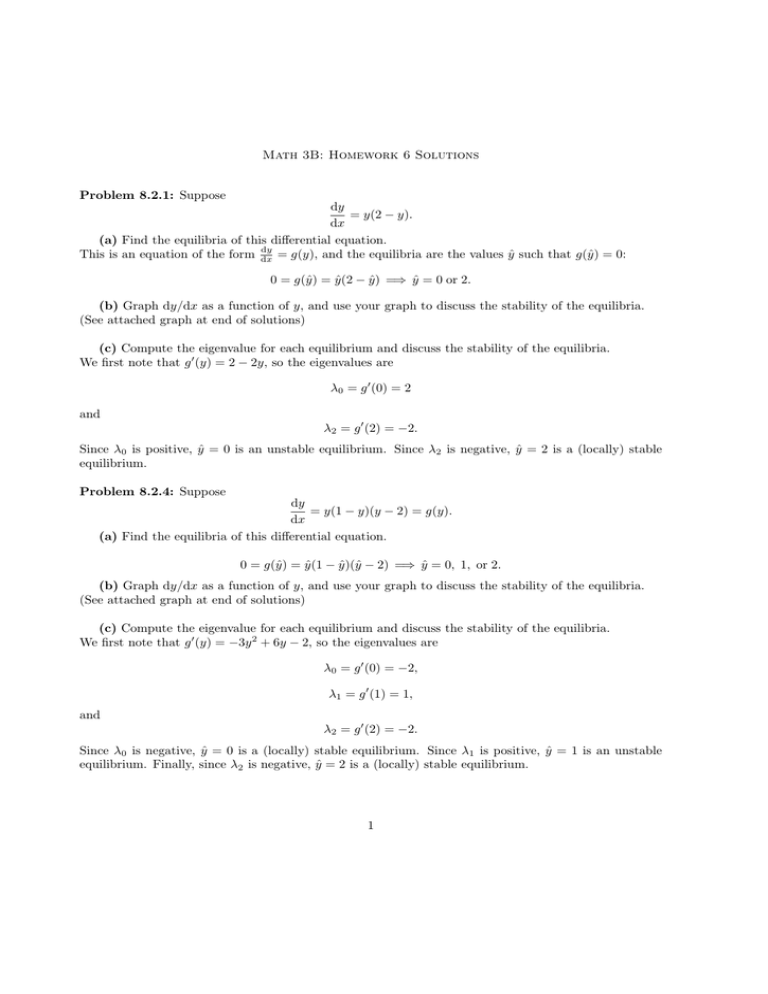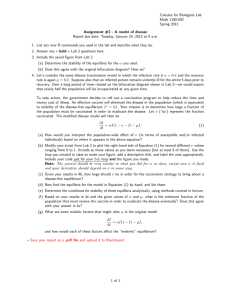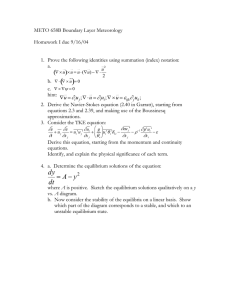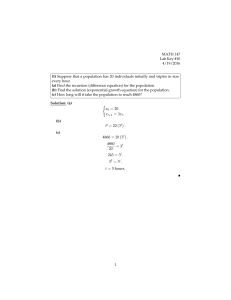Math 3B: Homework 6 Solutions Problem 8.2.1: Suppose dy dx = y(2
advertisement

Math 3B: Homework 6 Solutions Problem 8.2.1: Suppose dy = y(2 − y). dx (a) Find the equilibria of this differential equation. dy = g(y), and the equilibria are the values ŷ such that g(ŷ) = 0: This is an equation of the form dx 0 = g(ŷ) = ŷ(2 − ŷ) =⇒ ŷ = 0 or 2. (b) Graph dy/dx as a function of y, and use your graph to discuss the stability of the equilibria. (See attached graph at end of solutions) (c) Compute the eigenvalue for each equilibrium and discuss the stability of the equilibria. We first note that g 0 (y) = 2 − 2y, so the eigenvalues are λ0 = g 0 (0) = 2 and λ2 = g 0 (2) = −2. Since λ0 is positive, ŷ = 0 is an unstable equilibrium. Since λ2 is negative, ŷ = 2 is a (locally) stable equilibrium. Problem 8.2.4: Suppose dy = y(1 − y)(y − 2) = g(y). dx (a) Find the equilibria of this differential equation. 0 = g(ŷ) = ŷ(1 − ŷ)(ŷ − 2) =⇒ ŷ = 0, 1, or 2. (b) Graph dy/dx as a function of y, and use your graph to discuss the stability of the equilibria. (See attached graph at end of solutions) (c) Compute the eigenvalue for each equilibrium and discuss the stability of the equilibria. We first note that g 0 (y) = −3y 2 + 6y − 2, so the eigenvalues are λ0 = g 0 (0) = −2, λ1 = g 0 (1) = 1, and λ2 = g 0 (2) = −2. Since λ0 is negative, ŷ = 0 is a (locally) stable equilibrium. Since λ1 is positive, ŷ = 1 is an unstable equilibrium. Finally, since λ2 is negative, ŷ = 2 is a (locally) stable equilibrium. 1 Problem 8.2.9: Suppose that a fish population evolves according to the logistic equation and that a fixed number of fish per unit time are removed. That is, dN N = rN 1 − − H =: g(N ). dt K (a) Assume r = 2 and K = 1000. Find possible equilibria, and discuss their stability when H = 100. We’ll find the equilibria in terms of r, K, and H, and then we’ll plug in the prescribed values; this will come in handy for part (b). g is a quadratic in N , so we use the quadratic formula to find the equilibria: q −r ± r2 − 4Hr r b2 K b b b 0 = g(N ) = − N + rN − H =⇒ N = . 2r K −K Plugging in our values for r, K, and H yields p −2 ± 2 4/5 b ≈ 52.79 or 947.21. N= 1 250 The stability issues are best dealt with graphically; since the N 2 -coefficient of g(N ) is negative, the graph of g is a “downward-opening” parabola. This shows us that the smaller equilibrium (52.79) is unstable, while the larger equilibrium (947.21) is stable. (For an analogous situation, see the attached graph for problem 8.2.1.) (b) What is the maximal harvesting rate H that maintains a positive population size? This question is easiest to think about graphically. If we consider the graph of g(N ) = dN dt , we see that increasing H shifts the parabola downward. So if H is too large, dN will always be negative; i.e., the fish dt population will always be decreasing and will eventually reach 0. So we want the maximal H such that dN dt is non-negative at at least one value of N ; this will occur when the graph of g(N ) “just touches” the N -axis. But this happens when the quadratic g(N ) has a double real root, i.e. when the discriminant (“b2 − 4ac”) of the quadratic is zero. The discriminant is r2 − 4Hr/K (see part (a)), so the maximal harvesting rate is given by 4Hr rK r2 − = 0 =⇒ H = . K 4 Problem 9.4.2: Let x = [−4, 3, 1]0 and y = [0, −2, 3]0 . (a) x − y = [−4 − 0, 3 − (−2), 1 − 3]0 = [−4, 5, −2]0 . (b) 2x + 3y = [2(−4) + 3(0), 2(3) + 3(−2), 2(1) + 3(3)]0 = [−8, 0, 11]0 . (c) −x − 2y = [−(−4) − 2(0), −3 − 2(−2), −1 − 2(3)]0 = [4, 1, −7]0 . −−→ Problem 9.4.5: Let A = (0, 1, −3) and B = (−1, −1, 2). Find the vector representation of AB. −−→ AB = [−1 − 0, −1 − 1, 2 − (−3)]0 = [−1, −2, 5]0 . 2 Problem 9.4.8: Find the length of x = [−1, 4]0 . p √ |x| = (−1)2 + 42 = 17. Problem 9.4.17: Find the dot product of x = [0, −1, 3]0 and y = [−3, 1, 1]0 . x · y = 0 · (−3) + (−1) · 1 + 3 · 1 = 2. Problem 9.4.19: Use the dot product to compute the length of [0, −1, 2]0 . By comparing the formula for the length of a vector with the dot product formula, we get the identity √ |x| = x · x for any vector x. So with x = [0, −1, 2]0 , we get x · x = 0 · 0 + (−1) · (−1) + 2 · 2 = 5, so |x| = √ x·x= √ 5. Problem 9.4.25: Find the angle between x = [0, −1, 3]0 and y = [−3, 1, 1]0 . We use the identity x · y = |x||y| cos θ, where θ is the angle between x and y. Computation yields x · y = 2, √ |x| = 10, and |y| = √ 11. So we get cos θ = √ 2 2 =⇒ θ = arccos √ ≈ 1.379. 110 110 Problem 9.4.35: Find the equation for the line through (2, 1) that is perpendicular to [1, 2]0 . Applying the formula on p. 595 yields the equation x − 2 + 2(y − 1) = 0. 3






